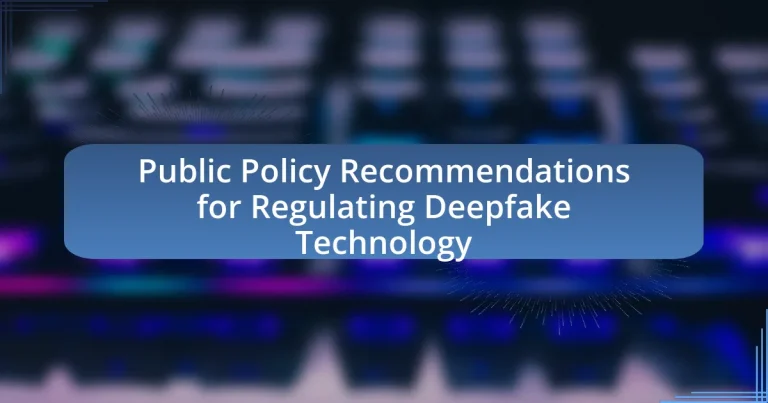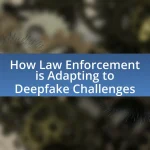The article focuses on public policy recommendations for regulating deepfake technology, emphasizing the need for clear legal definitions, labeling requirements for synthetic media, and enhanced penalties for malicious use. It highlights the importance of regulation to prevent misinformation, protect individual rights, and maintain public trust in media. The article discusses potential harms from unregulated deepfakes, challenges in creating effective regulations, and the role of stakeholders, including technology companies, in developing solutions. Additionally, it outlines existing frameworks that can inform regulation and suggests educational initiatives to raise public awareness about deepfakes.
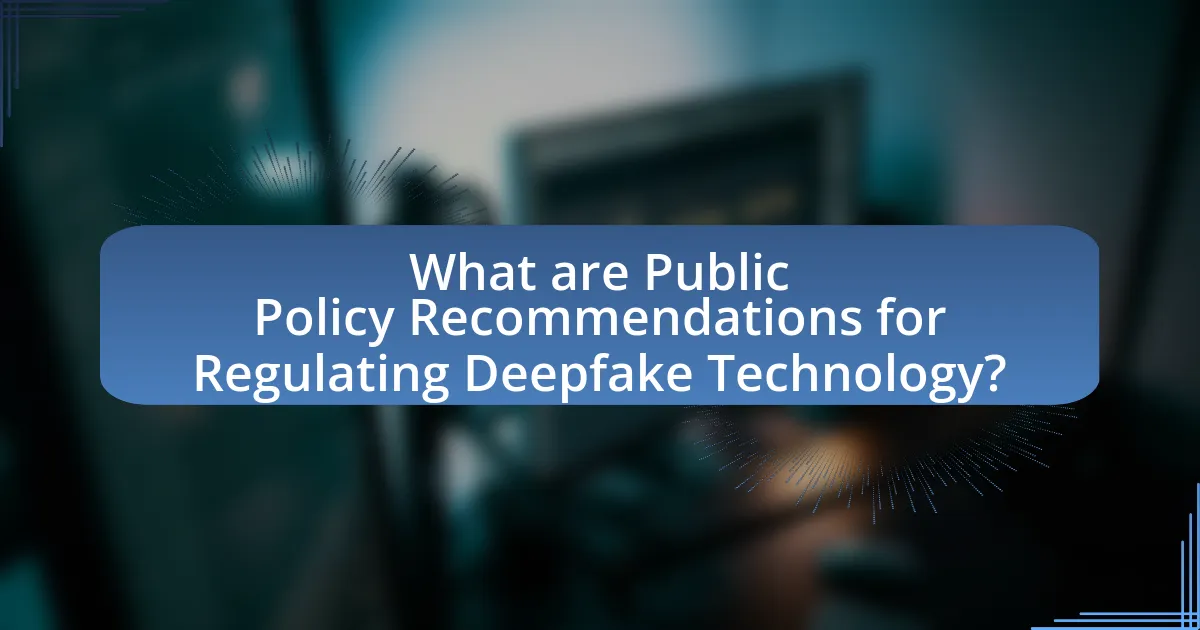
What are Public Policy Recommendations for Regulating Deepfake Technology?
Public policy recommendations for regulating deepfake technology include establishing clear legal definitions of deepfakes, implementing labeling requirements for synthetic media, and enhancing penalties for malicious use. Clear legal definitions help delineate between benign and harmful uses, ensuring that regulations target genuinely harmful applications. Labeling requirements can inform consumers about the authenticity of media, thereby reducing misinformation. Enhanced penalties for malicious use, such as defamation or fraud, can deter individuals from creating harmful deepfakes. These recommendations are supported by the increasing prevalence of deepfakes in misinformation campaigns, as highlighted by a 2020 report from the Deepfake Detection Challenge, which noted a significant rise in deepfake incidents across various platforms.
Why is regulating deepfake technology important for society?
Regulating deepfake technology is crucial for society to prevent misinformation and protect individual rights. Deepfakes can be used to create misleading content that undermines trust in media and institutions, as evidenced by incidents where manipulated videos have influenced public opinion and electoral processes. For instance, a study by the University of California, Berkeley, found that deepfake videos can significantly sway viewers’ perceptions, highlighting the potential for harm. Additionally, without regulation, individuals may face privacy violations and reputational damage from unauthorized deepfake creations, necessitating legal frameworks to safeguard against such abuses.
What potential harms can arise from unregulated deepfake technology?
Unregulated deepfake technology can lead to significant harms, including misinformation, identity theft, and erosion of trust in media. Misinformation can be spread rapidly through realistic deepfake videos, influencing public opinion and potentially swaying elections, as evidenced by incidents during the 2020 U.S. presidential election where manipulated videos circulated widely. Identity theft occurs when individuals’ likenesses are used without consent, leading to reputational damage and emotional distress, as seen in cases where deepfakes have been used for harassment or fraud. Additionally, the erosion of trust in media can result in a general skepticism towards authentic content, undermining societal discourse and democratic processes, as highlighted by studies showing that deepfakes can make it increasingly difficult for individuals to discern fact from fiction.
How can deepfakes impact public trust and safety?
Deepfakes can significantly undermine public trust and safety by spreading misinformation and creating false narratives. The realistic nature of deepfake technology allows malicious actors to fabricate videos or audio recordings that can mislead viewers, leading to confusion and distrust in legitimate media sources. For instance, a study by the Stanford Internet Observatory found that deepfakes can erode trust in political figures and institutions, as manipulated content can be used to falsely portray individuals in compromising situations. This erosion of trust can result in societal polarization and increased vulnerability to scams or propaganda, ultimately threatening public safety and democratic processes.
What are the key challenges in regulating deepfake technology?
The key challenges in regulating deepfake technology include the rapid pace of technological advancement, the difficulty in defining legal parameters, and the potential for misuse in various contexts. Rapid advancements in deepfake creation tools make it challenging for regulators to keep up, as new techniques emerge faster than laws can be enacted. Additionally, defining what constitutes a deepfake and establishing clear legal frameworks for accountability complicates enforcement efforts. Furthermore, the potential for deepfakes to be used in misinformation campaigns, harassment, and identity theft raises ethical concerns, making it difficult to balance regulation with freedom of expression. These challenges necessitate a nuanced approach to policy-making that considers both technological innovation and societal impact.
What legal and ethical dilemmas do policymakers face?
Policymakers face significant legal and ethical dilemmas regarding the regulation of deepfake technology, primarily concerning misinformation, privacy violations, and the potential for harm. The rapid advancement of deepfake technology raises questions about the balance between freedom of expression and the need to protect individuals from deceptive practices. For instance, deepfakes can be used to create misleading content that damages reputations or spreads false information, complicating the legal landscape surrounding defamation and fraud. Additionally, ethical concerns arise regarding consent, as individuals may be depicted in deepfake videos without their permission, infringing on their right to privacy. These dilemmas necessitate careful consideration of existing laws and the development of new regulations that address the unique challenges posed by deepfake technology while safeguarding civil liberties.
How does the rapid evolution of technology complicate regulation?
The rapid evolution of technology complicates regulation by outpacing the ability of lawmakers to create effective legal frameworks. As new technologies emerge, such as deepfake technology, they introduce unique challenges that existing regulations often fail to address, leading to gaps in legal protections. For instance, the rise of deepfakes has raised concerns about misinformation and privacy violations, yet regulatory bodies struggle to keep up with the speed of technological advancements, resulting in outdated or inadequate laws. This dynamic creates a regulatory lag, where the legal system cannot effectively mitigate risks associated with new technologies, as evidenced by the increasing incidents of deepfake misuse in political and social contexts.
What existing frameworks can inform deepfake regulation?
Existing frameworks that can inform deepfake regulation include the European Union’s General Data Protection Regulation (GDPR), which emphasizes data privacy and consent, and the Digital Services Act, which addresses harmful online content. The GDPR provides a legal basis for protecting individuals from unauthorized use of their likeness, while the Digital Services Act establishes accountability for platforms hosting deepfake content. Additionally, the U.S. Federal Trade Commission (FTC) guidelines on deceptive practices can serve as a model for regulating misleading deepfake applications. These frameworks collectively highlight the importance of consent, accountability, and transparency in the regulation of deepfake technology.
What lessons can be learned from other technology regulations?
Lessons from other technology regulations indicate the importance of proactive measures, stakeholder engagement, and adaptability. For instance, the General Data Protection Regulation (GDPR) in Europe emphasizes user consent and data protection, showcasing the need for clear guidelines that empower users while holding companies accountable. Additionally, the regulation of social media platforms, such as the Communications Decency Act in the United States, highlights the challenges of balancing free speech with harmful content moderation. These examples illustrate that effective technology regulation requires a comprehensive approach that considers ethical implications, technological advancements, and societal impacts, ensuring that regulations remain relevant and effective over time.
How do international regulations on digital content apply to deepfakes?
International regulations on digital content apply to deepfakes by establishing legal frameworks that address misinformation, privacy violations, and intellectual property rights. For instance, the European Union’s Digital Services Act aims to hold platforms accountable for harmful content, including deepfakes, by requiring them to implement measures for content moderation and transparency. Additionally, the United States has seen various state-level laws targeting the malicious use of deepfakes, particularly in contexts like election interference and non-consensual pornography. These regulations are designed to mitigate the risks associated with deepfakes, ensuring that creators and distributors of digital content adhere to ethical standards and legal obligations.
How can stakeholders collaborate to create effective regulations?
Stakeholders can collaborate to create effective regulations by establishing multi-stakeholder forums that include government agencies, industry representatives, and civil society organizations. These forums facilitate open dialogue, allowing stakeholders to share insights, concerns, and expertise regarding deepfake technology. For instance, the European Union’s approach to regulating digital technologies emphasizes stakeholder engagement through public consultations and expert groups, which has led to more comprehensive and balanced regulations. This collaborative process ensures that diverse perspectives are considered, ultimately leading to regulations that are both effective and adaptable to evolving technological landscapes.
What role do technology companies play in regulating deepfakes?
Technology companies play a crucial role in regulating deepfakes by developing detection tools, implementing content moderation policies, and collaborating with policymakers. These companies, such as Facebook and Google, have invested in artificial intelligence technologies that can identify manipulated media, thereby helping to mitigate the spread of harmful deepfakes. For instance, Facebook has partnered with academic institutions to enhance its deepfake detection capabilities, demonstrating a proactive approach to addressing the issue. Additionally, these companies enforce community guidelines that prohibit the sharing of misleading content, which further aids in regulating deepfakes.
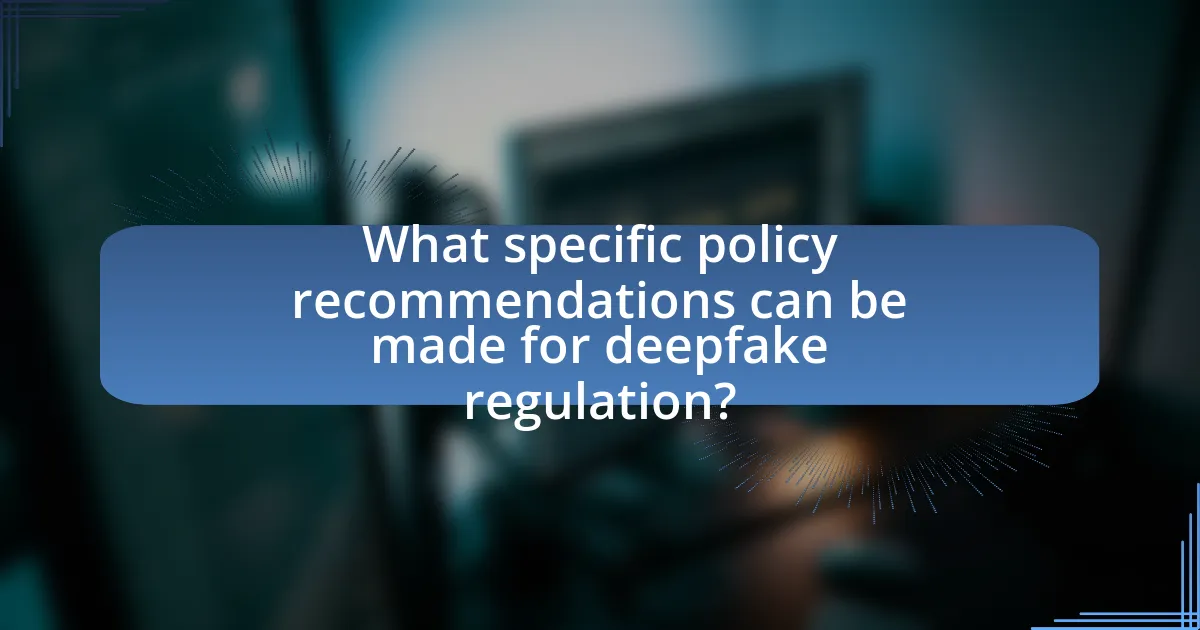
What specific policy recommendations can be made for deepfake regulation?
Specific policy recommendations for deepfake regulation include establishing clear legal definitions of deepfakes, implementing mandatory labeling requirements for synthetic media, and creating penalties for malicious use. Clear legal definitions will help law enforcement and the judiciary address deepfake-related crimes effectively, as seen in California’s law that criminalizes the use of deepfakes for harassment or fraud. Mandatory labeling can enhance transparency, similar to the approach taken by platforms like Facebook, which labels manipulated media to inform users. Additionally, penalties for malicious use can deter harmful applications, as evidenced by existing laws against identity theft and fraud, which serve as a framework for enforcing consequences in deepfake cases.
What are the proposed legal frameworks for regulating deepfakes?
Proposed legal frameworks for regulating deepfakes include a combination of existing laws and new legislation specifically targeting the technology. These frameworks often suggest amending current laws on defamation, fraud, and copyright to encompass deepfake content, while also advocating for the creation of specific laws that criminalize malicious deepfake use, such as identity theft or misinformation. For instance, California’s AB 730, enacted in 2019, prohibits the use of deepfakes to harm or defraud individuals, demonstrating a legislative approach to address the issue. Additionally, some proposals recommend establishing a regulatory body to oversee deepfake technology and enforce compliance with ethical standards, ensuring accountability among creators and distributors of deepfake content.
How can laws be structured to address the unique challenges of deepfakes?
Laws can be structured to address the unique challenges of deepfakes by implementing specific regulations that define and penalize the malicious use of this technology. These regulations should include clear definitions of deepfakes, establish liability for creators and distributors of harmful deepfake content, and provide legal recourse for victims of deepfake-related harms, such as defamation or identity theft. For instance, California’s AB 730 law criminalizes the use of deepfakes for malicious purposes, demonstrating a legislative approach that can serve as a model for other jurisdictions. Additionally, laws should mandate transparency requirements for platforms hosting user-generated content, ensuring that deepfake materials are labeled appropriately to inform viewers. This structured legal framework can help mitigate the risks associated with deepfakes while protecting individuals’ rights and promoting accountability among technology developers.
What penalties should be established for misuse of deepfake technology?
Penalties for misuse of deepfake technology should include criminal charges, civil liabilities, and fines. Criminal charges can range from misdemeanors for minor offenses to felonies for severe cases, such as defamation or fraud, reflecting the potential harm caused by the misuse. Civil liabilities can involve compensatory damages to victims, which serve to address the financial impact of the misuse. Fines should be substantial enough to deter individuals and organizations from engaging in harmful deepfake activities, with amounts potentially reaching thousands of dollars depending on the severity of the offense. These penalties are essential to protect individuals from identity theft, harassment, and misinformation, as evidenced by increasing incidents of deepfake-related crimes reported in various jurisdictions.
What educational initiatives can support deepfake regulation?
Educational initiatives that can support deepfake regulation include comprehensive digital literacy programs, which educate individuals about the nature and implications of deepfake technology. These programs can be integrated into school curricula and community workshops, focusing on critical thinking skills, media literacy, and the ethical use of technology. Research indicates that enhancing digital literacy can empower individuals to discern between authentic and manipulated content, thereby reducing the potential harm caused by deepfakes. For instance, a study by the Stanford History Education Group found that students who received instruction on evaluating online information were better equipped to identify misinformation. Such educational efforts can foster a more informed public, ultimately supporting regulatory measures by creating a populace that understands the risks associated with deepfakes.
How can public awareness campaigns mitigate the risks of deepfakes?
Public awareness campaigns can mitigate the risks of deepfakes by educating the public about the existence and potential dangers of manipulated media. These campaigns can inform individuals on how to identify deepfakes, thereby reducing the likelihood of misinformation spreading. For instance, a study by the Pew Research Center found that 86% of Americans believe that misinformation is a major problem, highlighting the need for increased awareness. By providing resources and tools for critical media consumption, public awareness initiatives can empower individuals to question the authenticity of digital content, ultimately fostering a more informed society that is less susceptible to the harmful effects of deepfakes.
What role does media literacy play in combating deepfake misinformation?
Media literacy plays a crucial role in combating deepfake misinformation by equipping individuals with the skills to critically analyze and evaluate digital content. This enhanced ability allows people to discern between authentic and manipulated media, thereby reducing the likelihood of being misled by deepfakes. Research indicates that media literacy programs can significantly improve individuals’ understanding of digital media, with studies showing that participants in such programs are 30% more likely to identify deepfake content accurately compared to those without media literacy training. By fostering critical thinking and skepticism towards media sources, media literacy serves as a vital defense against the spread of deepfake misinformation.
What technological solutions can aid in the regulation of deepfakes?
Technological solutions that can aid in the regulation of deepfakes include detection algorithms, blockchain technology, and watermarking techniques. Detection algorithms utilize machine learning to identify manipulated content by analyzing inconsistencies in video and audio data, with studies showing that advanced models can achieve over 90% accuracy in distinguishing deepfakes from authentic media. Blockchain technology offers a decentralized method for verifying the authenticity of digital content, allowing users to trace the origin and modifications of media files, thereby enhancing accountability. Watermarking techniques embed identifiable information within the media, making it easier to track and verify the source of content, which can deter malicious use of deepfakes. These solutions collectively contribute to a more robust framework for managing the risks associated with deepfake technology.
How can detection tools be developed and implemented effectively?
Detection tools can be developed and implemented effectively by utilizing advanced machine learning algorithms and ensuring continuous updates based on evolving deepfake techniques. Machine learning models, particularly convolutional neural networks, have shown high accuracy in identifying manipulated media, as evidenced by research from the University of California, Berkeley, which demonstrated a 95% detection rate in controlled environments. Furthermore, collaboration between technology developers, policymakers, and researchers is essential to create standardized benchmarks and datasets for training these tools, ensuring they remain effective against new deepfake methods. Regular assessments and user feedback can also enhance the tools’ performance and adaptability in real-world scenarios.
What innovations are needed to stay ahead of deepfake technology?
To stay ahead of deepfake technology, innovations in detection algorithms and digital watermarking are essential. Advanced detection algorithms utilizing machine learning can analyze video and audio for inconsistencies that indicate manipulation, thereby improving the accuracy of identifying deepfakes. For instance, research from the University of California, Berkeley, demonstrates that deep learning models can achieve over 90% accuracy in detecting manipulated media. Additionally, implementing digital watermarking techniques can embed identifiable information within original content, making it easier to trace and verify authenticity. These innovations are crucial for maintaining trust in digital media and combating the potential misuse of deepfake technology.
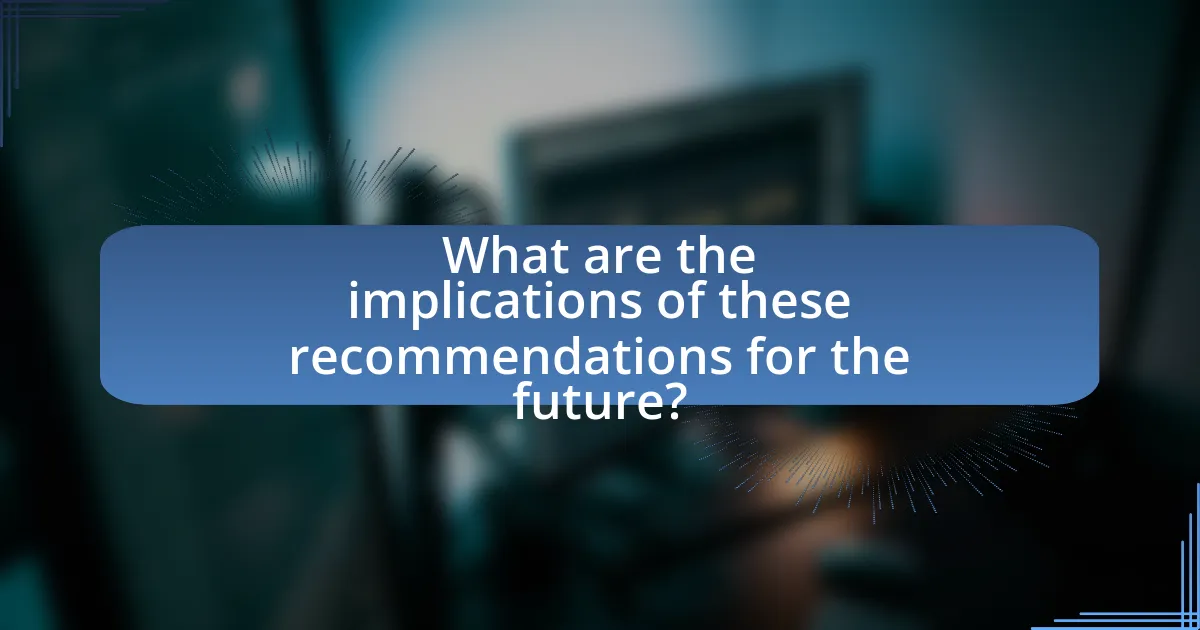
What are the implications of these recommendations for the future?
The implications of the recommendations for regulating deepfake technology include enhanced legal frameworks that protect individuals from misinformation and identity theft. By establishing clear guidelines and penalties for the misuse of deepfake technology, policymakers can deter malicious actors and promote responsible use. For instance, countries that have implemented similar regulations, such as the United States with its proposed legislation against deepfake distribution, have seen a reduction in the spread of harmful content. This proactive approach not only safeguards public trust in digital media but also encourages technological innovation within ethical boundaries.
How will effective regulation impact the development of deepfake technology?
Effective regulation will likely lead to a more responsible development of deepfake technology by establishing clear legal frameworks that deter misuse. Regulations can enforce accountability among developers and users, thereby reducing the potential for harmful applications such as misinformation and identity theft. For instance, countries like the United States and the European Union are already considering or implementing laws that require transparency in the creation and use of deepfakes, which can foster ethical standards in the industry. This regulatory approach can encourage innovation while ensuring that the technology is used in ways that respect privacy and public safety.
What balance should be struck between innovation and regulation?
A balance between innovation and regulation should prioritize fostering technological advancement while ensuring public safety and ethical standards. Innovation drives economic growth and societal benefits, as seen in the rapid development of artificial intelligence and digital media technologies. However, regulation is essential to mitigate risks associated with misuse, such as misinformation and privacy violations, particularly in the context of deepfake technology, which can manipulate reality and deceive audiences. Effective regulation can be achieved through adaptive frameworks that encourage responsible innovation, such as establishing clear guidelines for deepfake creation and distribution, while also promoting transparency and accountability among developers. This approach ensures that technological progress does not come at the expense of societal trust and safety.
How can regulations evolve alongside technological advancements?
Regulations can evolve alongside technological advancements by adopting a flexible framework that allows for continuous assessment and adaptation. This approach enables policymakers to respond to emerging technologies, such as deepfake technology, by implementing iterative regulatory processes that incorporate stakeholder feedback and technological insights. For instance, the rapid development of artificial intelligence necessitates regular updates to existing laws to address new ethical concerns and potential misuse, as seen in the European Union’s proposed AI Act, which aims to create a legal framework that evolves with AI advancements. This proactive regulatory stance ensures that laws remain relevant and effective in mitigating risks associated with technological innovations.
What best practices should policymakers follow when regulating deepfakes?
Policymakers should prioritize transparency, accountability, and public awareness when regulating deepfakes. Transparency involves requiring platforms to disclose the use of deepfake technology, enabling users to identify manipulated content. Accountability can be established through legal frameworks that define the consequences for malicious use of deepfakes, such as fraud or defamation. Public awareness campaigns are essential to educate citizens about the existence and potential dangers of deepfakes, fostering critical media literacy. Research indicates that informed users are better equipped to discern manipulated content, thereby reducing the impact of misinformation.
How can policymakers ensure stakeholder engagement in the regulatory process?
Policymakers can ensure stakeholder engagement in the regulatory process by implementing structured consultation mechanisms that actively involve diverse groups, including industry representatives, civil society, and affected communities. These mechanisms can include public forums, surveys, and advisory committees that facilitate open dialogue and feedback on proposed regulations. For instance, the European Union’s General Data Protection Regulation (GDPR) process included extensive stakeholder consultations, which helped shape the final legislation by incorporating various perspectives and concerns. This approach not only enhances transparency but also builds trust among stakeholders, leading to more effective and widely accepted regulations.
What ongoing assessments are necessary to adapt regulations over time?
Ongoing assessments necessary to adapt regulations over time include continuous monitoring of technological advancements, stakeholder feedback, and impact evaluations. Continuous monitoring of technological advancements ensures that regulations remain relevant as deepfake technology evolves, with specific attention to new methods of creation and dissemination. Stakeholder feedback from industry experts, civil society, and affected communities provides insights into the effectiveness and unintended consequences of existing regulations. Impact evaluations assess the outcomes of regulations on public safety, misinformation, and individual rights, allowing policymakers to make data-driven adjustments. These assessments are crucial for maintaining effective and adaptive regulatory frameworks in the rapidly changing landscape of deepfake technology.
